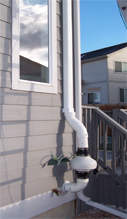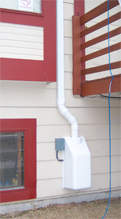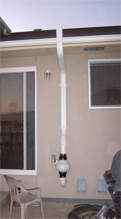



It All Starts With the System… and All Mitigation Systems Are Not the Same
In our experience, there are Five Classes of Mitigation Systems available in the marketplace – each are described in detail below. Be sure to check this out because a lot of people think they’re getting a Class A Mitigation System and pay for one, but don’t because they don’t know what questions to ask. Some Mitigation Systems work great – some just kill real estate deals, cause headaches, and waste lots and lots of money.
A Great Mitigation System:
- Saves lives by getting levels down and KEEPING them down
- Assures families
- Keeps real estate transactions alive
- Saves home sellers tens of thousands of dollars (or more) in lost buyers
- And saves Brokerage commissions.
A “Short Cut System”
- Usually aims for the minimum acceptable EPA remediation threshold level, not a significantly better level, and often misses this mark and kills real estate transactions.
- Often has loop-hole filled guarantees and often take several attempts to get your levels down.
- Scares buyers and creates discomfort and uncertainty in their Agents and Inspectors.
- Can create a situation where a seller is apologizing to future buyers for this aspect of their home, explaining why previous transactions failed, and giving away all leverage in negotiations and costing the seller tens of thousands of dollars or more.
And The Cost?
The difference between a great system that can save deals, protect people’s lives, and prevent costly and emotionally painful lawsuits and a lousy system that can endanger people, kill sales, and cause endless headaches is just a few dollars.


So…What Constitutes a Good Mitigation System?
The Five Classes of Radon Mitigation Systems
Let’s start at the bottom…
Class “D” and “F” Radon Mitigation Systems
There are truly bad systems. Most people think… “I couldn’t get tricked into one of these,” but we fix systems for smart, nice people who get fooled all the time. It’s hard to believe, but these often are installed by the largest companies. Gleaming websites, glowing testimonials and lots of smoke about who is actually certified and “strict adherence to EPA protocol.” We saw one of these the other day that violated EPA protocols in too many ways to count.
Some D”s & F’s turn out to be “bait and switches.” We recently met one owner who thought she had a guarantee, but had to pay full price for the second system and then was offered a 3rd system for another 66% of the original price – they told her they were going to do her a favor. The original company never did get the levels down.
D’s & F’s are lawsuits waiting to happen.
A “D” or “F” might include awful errors like:
- Placing the fan inside the living space of the home. This is horrible because fan problems could blast Radon INTO your home. (We’ve seen where the installing company told the homeowner it was a “dehumidifying system to assist in lowering Radon” because they knew the homeowner might find out what an awful practice it is to put the Radon fan in the living space.)


Class C Mitigation Systems are probably the most common.
Some major characteristics of a C are:
- The goal with a Class C system is to dip your level to 3.9 pCiL for the brief period following the installation in which the re-test takes place. It may take a few tries, but they’re shooting for it.
- Some Mitigators we know have nicknamed this “The Three Strikes” system because they know they have three tries before they even get started. (This can be big trouble if you’re selling a home.)
- They usually spend 1 to 4 hours on install, but time is money so they “shake a leg.”
Problems with the “C” often include:
- Pennies are tight so you’re not getting much of a fan – it’s often manufactured in a developing nation sweatshop where quality control is low on the list of priorities. The biggest problem with this is that a cheap fan can get noisier and weaker quickly. Noisy is just annoying, but a weaker fan pulls less air and your Radon levels will rise if your fan pulls less air.
- Though these appear to be priced competitively, they’re really a rip-off because you’re getting so little for your money.
- The tech is hurrying so you don’t get much of a suction pit or sub-slab air distribution system which often makes the difference between a 3.9 pCiL and a 1.9 pCil radon concentrations in your home.
- These systems often stick out like a sore thumb and detract from the looks of your home.


Class B Systems are a little better and usually cost a few hundred dollars more.
- The B is usually 75% EPA Protocol compliant. It generally gets the job done.
Some problems with the “B” might be:
- Higher exhaust discharge, but still below the eave of the roof.
- PVC exterior piping…rather than the premium downspout materials we use.
- Decent, but not excellent, suction pit location and size (a difference of one or two pCiL?)
-
Limited or no caulking of interior air penetrations.
Class A Systems
These are the top-of-the line systems we install.
(Let’s also say right here: we are not the only mitigators around who install “A” systems. There are some other real pros out there and if, for whatever reason, you don’t like us, we’ll glady refer you to one. But these are by far the exception and not the rule and as a buyer you need to know what you’re getting.)Systems have a tendency to make the largest Radon level change when they’re first installed, then after that their effectiveness can diminish. These fluctuations can be based on environmental issues such as seasonal temperature fluctuations and soil moisture content or they can be based on system issues such as weakening fan power, leaky plumbing, poor interior sealing, or just plain poor system design. The only way to get the Radon level as low as possible for as long as possible is to install the best system possible. Just a few of the factors that effect long term system performance include:
– A Gigantic Sub Slab Air Induction Zone. The EPA says remove at least 5 gallons of soil, The CO Dept of Health recommend 5 to 10 gallons of soil. We use the best industrial vacuuming system in the world and we try to fill it 3 times. It is so powerful that it can pull soil by the bucketful and even rocks the size of baseballs from under your home in rapid succession. This usually equates to 20 to 30 gallons of soil removed. (Often 3 trash cans full!) This can make a difference of several pCiL in your Radon levels. Why don’t most others do this? They don’t start out with the right goals and they don’t have the tools to make it easy.
– Better Slab Core Hole and Induction Bushing A hole is a hole right? Not so fast. The easy way method is to bore a 4 inch hole. But a 4 incher doesn’t give you enough room to clear the effective suction zone described above. It also limits induction airflow at the point that is most crucial. Our 6 inch core also allows us to use a professionally made 6″ bushing that is like a giant vacuum cleaner for the radon under your home. A lot of the “B” to “F” systems install a homemade fitting to save money on parts and these can restrict airflow not to mention fail, clog, or leak over time.
– Induction Location. We use our expertise to choose the most effective location for suction points. This can be tricky, but we see horrible choices in other’s systems all the time. One quick secret: locate where you can leverage the existing sub slab air flow patterns – if you can tap into plumbing chases, drains, and other gaps, you can get triple or quadruple the effectiveness of random placement.
– Fan Quality. Most of the fans we use are manufactured by the World’s Leading Radon Fan Company. They’re located in Florida and have facilities all over the US, Canada, and Europe. The fans are UL listed for outdoor use and they adhere to strict quality control procedures unlike bulk fan producers/suppliers located in developing nations. When it comes to your safety, it would be absurd for us to do anything other than invest in the best fan product in terms of size, power and reliability rating. A better fan continues to perform at a high level over the years and keeps your system working as well as it did on the first day it was installed.
– Exterior Wall Penetration This is another thing that sounds incredibly simple and yet we see it done wrong all the time. (We see firewalls being penetrated without fire collars, we see floor joists cut and damaged to make the install easier, and many other shortcuts.) When we’re doing an interior to exterior penetration, the proper place is through the band joist, above the sill plate and rim joist, but below the floor joists. After proper selection, we get the best plumbing alignment and balance by drilling a pilot hole and using that as a guide to place our wall core. We get the best fan assembly placement above our wall core by leaving 3.5 inches of plumbing protruding from the core. We then use industrial sealant to make the penetration air & water proof and use decorative flanges to enhance it’s visual appeal. When someone just “picks a spot,” drills a hole, and “rigs it up,” it rarely works like it should and it almost always looks awful.
– Enhanced Radon Pathway Engineering. The idea of a Radon System is to capture the Radon beneath your home, encapsulate it safely within the system, and transport it to a point above your roofline to be released into the atmosphere. The more efficient the pathway is, the more effective your system will be. By minimizing turns in your pathway, never allowing a “downward” slope, and keeping it moving vertically (upward) whenever possible, we can get and keep your interior Radon levels lower.
– Top Quality Pathway Fabrication Materials. Although EPA Protocol allows use of lesser Schedule 20 inside of the home, we use only Schedule 40 PVC vent pipe materials and 95% of the time we use 4″ piping for better airflow. We support it with solid brackets to protect it from damage from leaking Radon into the home.
– Prudent & Compliant Radon Exhaust Point. We use skill to choose and locate the exhaust in the best ABOVE ROOFLINE (EPA requirement) location. Lots of systems violate this rule because the installer didn’t know it or didn’t have the proper ladders with him to install it.
– Rodent / Bird Screens. (Protects your fan) Critters like warm air in the winter and cool air in the summer. When they get into your system they end up ruining your fan. This costs you money if you realize it and gives you higher radon levels if you don’t. We thoroughly screen all openings to keep you safe.
– Hydro Sep Device (Protects your fan) It’s normal for condensation and water to collect in your venting system above the fan assembly. However, you don’t want it to run back through your fan. We install these water diversion mechanisms directly above all our fans to protect them. Once again, if the fan weakens, it will lessen the effectiveness of your system.
– Thorough Interior Penetration Sealing is relatively expensive and time consuming work. And a Mitigator can usually dip Radon levels below the remediation threshold for some time without doing it. That is why most don’t bother with it or just do a little. And there is also a real financial risk to you with this: when you don’t seal, you often draw heated or cooled air from the home. You then pay for energy to replace this lost air. If it cost you $28 per month over 5 years, it would bump the price of your Radon system by $1680! This is true of all systems, but can be especially true of crawlspace systems. We commit to generous sealing in terms of: amount, high quality product, and application skill.
– Superior Radon Barrier Quality. Most just use standard sheeting which has a tensile strength of 2215 PSI and tear force of about 8.1 lbs. Why? It is much cheaper. We have a deluxe high-density polyethylene, two-ply cross laminated 4 mil product that has a tensile strength of 7250 PSI and a tear force of about 40lbs! Why does this matter? If you want the system to continue performing over time, you need a barrier that won’t break down. This barrier will have to handle a pressure load every minute or every day for as long as you own your home. Plus, you’re bound to need to access the space from time to time for storage, to have your furnace serviced, or for plumbing or electrical maintenance. If it’s cheap, you’ll get punctures and have systems performance problems. Plus, we’ve done extensive testing to match our caulking sealants with our membranes, so that the bond you get on that first day lasts over time and these are just a few of the many critical things to system performance.


The only way to design and build systems this good is to clearly define and articulate your standards. If they’re not promoting and describing them, they’re certainly not executing them! We fix other’s systems all the time and believe me… most systems are only a fraction as good as they could be!
We sell Radon Reduction Systems that are so good we will fix them if they fall short anytime in the first ten years AND we offer multiple free re-tests so you will know how your system is performing! When it comes to Radon Systems, we are “in it together” with you and will fight relentlessly to keep your home safe.
And Finally: How will it Look?
We take great pride in the appearance of our stsyems. When possible we locate them in discreet locations. We offer casings to enclose the fan when appropriate. Above the fan assembly, where many others continue the run of ugly PVC piping, we use only high-grade, great looking, house-matching downspout materials to vent the air to the roofline. We often get referrals because we’ll do a system in a neighborhood and folks there will compare our system to others nearby and come get our phone number off the sticker on the system. (true story!)
A No-Risk, No Hassle, Free Way to Learn More
We offer a quick, easy 20 minute estimates to provide you with pricing and other valuable information. Just call our main office line at 303-462-5000 and say, “I saw you on the web and I’d like to get a proposal for a Radon Mitigation System” and we can set up a time that works for you. You’ll never get any sales-pitch whatsoever. We love to do these no-charge consultations, even if you’re not ready to move forward right now. Our goal is to make it as easy and painless as possible to look into this with no-strings attached. (We’re also happy to do phone consultations to give you the basics and answer any questions you have.)
